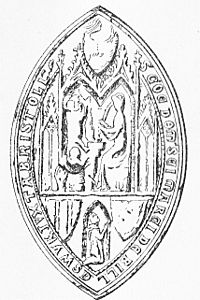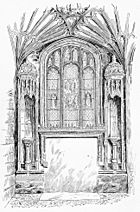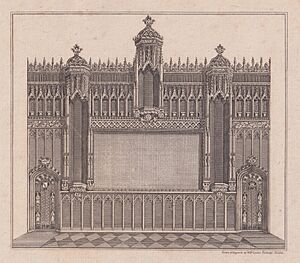St Mark's Church, Bristol facts for kids
St Mark's Church is a very old church in Bristol, England, located on College Green. It was built around the year 1230. Today, it is often called the Lord Mayor's Chapel. In the past, it was known as the Gaunt's Chapel.
This church is special because it is one of only two churches in England that are privately owned and used by a city government. The other is St Lawrence Jewry in London. The chapel stands across a large grassy area from Bristol Cathedral. This green space used to be a graveyard for both churches.
The chapel was first built for a hospital that helped the sick and poor. The hospital building is no longer there, but the beautiful church still stands. It has amazing Gothic designs and a collection of colorful stained glass from different parts of Europe. It is so important that it is protected as a grade I listed building.
Contents
How the Chapel Began
In 1220, a man named Maurice de Gaunt started a hospital to care for the sick and poor. He was from the powerful Berkeley family who lived in the nearby Berkeley Castle. The hospital was called the "Hospital of St Mark of Billeswyke-by-Bristol."
When Maurice died in 1230, his nephew Robert de Gournay gave more money to the hospital. This made it separate from the nearby St Augustine's Abbey. The church we see today was built around 1230 as the chapel for the hospital's residents.
Famous People Buried Here
The church has several large, decorated tombs called chest tombs. Some of these belong to important people from Bristol's history.
- Two tombs in the south aisle chapel might hold the church's founders, Maurice de Gaunt and Robert de Gournay.
- Miles Salley (died 1516), who was the Bishop of Llandaff, is buried near the altar.
- Members of the Berkeley family and the Poyntz family are also buried here.
- Thomas James (died 1635), an explorer who sailed to the Arctic. James Bay in Canada is named after him.
- Sir Richard Berkeley (died 1604) has a tomb with a statue of him lying down.
A Change in Ownership
In the 1530s, King Henry VIII began to close down many religious houses in England. This was called the Dissolution of the Monasteries. In 1535, agents of the king visited Bristol to close St Augustine's Abbey and the Gaunt's Hospital.
After this, the hospital and its chapel were taken over. In 1540, the Bristol Corporation (the city's government) bought the church.
A School and a New Community
From 1590 to 1767, a school called Queen Elizabeth's Hospital used the old hospital building. The students used St Mark's Church as their chapel.
Later, in the 1600s, many French Protestants called Huguenots moved to Bristol to escape trouble in France. From 1687 to 1722, the city allowed them to use the chapel for their church services.
The Lord Mayor's Chapel
In 1722, the church officially became the chapel for the Mayor and Corporation of Bristol. It has been known as the Lord Mayor's Chapel ever since.
The Chapel's Amazing Architecture
The main part of the church, called the nave, was built around 1230. The south aisle (a side hallway) was added around 1270. These sections are in an early Gothic style.
The rest of the church was built later in a style called Perpendicular Gothic, which has more complex patterns. The tower was finished in 1487. The front of the church, with its beautiful 12-petalled rose window, was rebuilt around 1830.
The Poyntz Chapel
A special addition to the church is the Poyntz Chapel. It was built around 1523 by Sir Robert Poyntz. He was a supporter of King Henry VII.
This small chapel has a stunning fan-vaulted ceiling, which looks like giant stone fans spreading across it. The floor is covered with colorful Spanish tiles that are as old as the chapel itself.
Beautiful Stained Glass
In the 1800s, the city of Bristol bought a collection of stained glass from Europe for the chapel.
- The East window has a 15th-century French window showing two saints.
- There is 16th-century glass from France and Germany in the nave and the Poyntz Chapel.
- The south aisle has 24 small, round glass pictures from Germany and Flanders (modern-day Belgium).
Special Features Inside
The chapel has beautiful ironwork made by a Bristol blacksmith named William Edney in the early 1700s. This includes a fancy stand for the mayor's sword and an iron screen. These were moved from another church in Bristol after it was damaged during World War II.
The medieval screen behind the main altar was hidden behind wood panels in 1722. It was uncovered in 1820 for everyone to see again.
Records and Current Use
Historical records for the Lord Mayor's Chapel are kept at the Bristol Archives. These include documents about the building, its finances, and church services.
Today, the church is open for visitors and for worship. It is a living piece of Bristol's history that people can still enjoy.
See also
- Churches in Bristol
- Grade I listed buildings in Bristol







